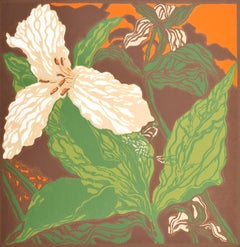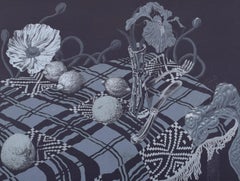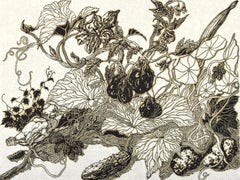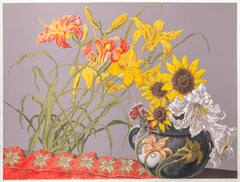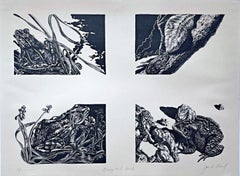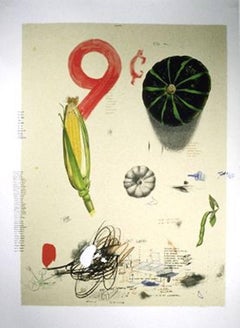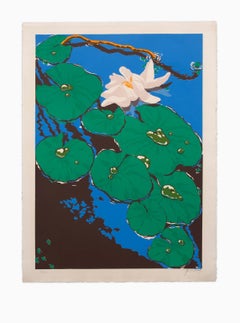Jack Beal Art
American, 1931-2013
Walter Henry "Jack" Beal Jr. was an American realist painterto
1
5
4
2
Overall Width
to
Overall Height
to
12
7
1
2
1
10
2
6
5
5
4
4
4
3
2
2
1
1
1
1
1
6
3
3
12
8,049
5,263
2,504
1,658
12
Artist: Jack Beal
Jack Beal TRILLIUM Linocut
By Jack Beal
Located in Lake Worth Beach, FL
Artist/Designer; Manufacturer: Jack Beal (American, 1921-2013)
Marking(s); notes: signed; AP X for the edition of 50
Materials: ...
Marking(s); notes: signed; AP X for the edition of 50
Materials: ...
Category
20th Century Jack Beal Art
Materials
Linocut
Jack Beal STILL LIFE II Lithograph
By Jack Beal
Located in Lake Worth Beach, FL
Artist/Designer; Manufacturer: Jack Beal (American, 1921-2013)
Marking(s); notes: signed, blind stamp; Trial; 1978
Materials:
Marking(s); notes: signed, blind stamp; Trial; 1978
Materials:
Category
20th Century Jack Beal Art
Materials
Lithograph
Jack Beal KIDDO Linocut
By Jack Beal
Located in Lake Worth Beach, FL
Artist/Designer; Manufacturer: Jack Beal (American, 1921-2013)
Marking(s); notes: signed; AP 2/6 for the edition of 27; 1977-78
...
Marking(s); notes: signed; AP 2/6 for the edition of 27; 1977-78
...
Category
20th Century Jack Beal Art
Materials
Linocut
Buds, Still Life Silkscreen by Jack Beal
By Jack Beal
Located in Long Island City, NY
Artist: Jack Beal, American (1931 - 2013)
Title: Buds
Year: circa 1975
Medium: Silkscreen, signed and numbered in pencil
Edition: 50
Size: 31 in. x 41 in. (78.74 cm x 104.14 cm)
Category
1970s American Realist Jack Beal Art
Materials
Screen
Blue Crab, Silkscreen by Jack Beal
By Jack Beal
Located in Long Island City, NY
Artist: Jack Beal, American (1931 - 2013)
Title: Blue Crab
Year: circa 1975
Medium: Silkscreen, Signed and numbered in pencil
Edition: 52
Image Size: 9 x 12 ...
Category
1970s American Realist Jack Beal Art
Materials
Screen
Frogs and Toad, Signed lithograph (AP), from Conspiracy: The Artist as Witness
By Jack Beal
Located in New York, NY
Jack Beal
Frogs and Toad, 1971
Hand signed in pencil by Jack Beal, annotated AP
One-color lithograph proofed by hand and pulled by machine from a zinc plate on Arches buff paper with deckled edges at the Shorewood Bank Street Atelier
Stamped, hand numbered AP, aside from the regular edition of 150 Stamped on reverse: COPYRIGHT © 1971 BY JACK BEAL, bears blind stamp
18 × 24 inches
Unframed
18 x 24 inches
Stamped on reverse: COPYRIGHT © 1971 BY JACK BEAL, bears distinctive blind stamp of publisher (shown) Publisher: David Godine, Center for Constitutional Rights, Washington, D.C.
Jack Beal's "Frogs and Toads" is a classic example of protest art from the early 1970s - the most influential era until today. This historic graphic was created for the legendary portfolio "CONSPIRACY: the Artist as Witness", to raise money for the legal defense of the Chicago 8 - a group of anti-Vietnam War activists indicted by President Nixon's Attorney General John Mitchell for conspiring to riot during the 1968 Democratic National Convention. (1968 was also the year Bobby Kennedy was killed and American casualties in Vietnam exceeded 30,000.) The eight demonstrators included Abbie Hoffman, Jerry Rubin, David Dellinger, Tom Hayden, Rennie Davis, John Froines, Lee Weiner, and Bobby Seale. (The eighth activist, Bobby Seale, was severed from the case and sentenced to four years for contempt after being handcuffed, shackled to a chair and gagged.) Although Abbie Hoffman would later joke that these radicals couldn't even agree on lunch, the jury convicted them of conspiracy, with one juror proclaiming the demonstrators "should have been shot down by the police." All of the convictions were ultimately overturned by the 7th Circuit Court of Appeals.
This lithograph has fine provenance: it comes directly from the original Portfolio: "Conspiracy The Artist as Witness" which also featured works by Alexander Calder, Nancy Spero and Leon Golub, Romare Bearden Sol Lewitt, Robert Morris, Claes Oldenburg, Larry Poons, Peter Saul, Raphael Soyer and Frank Stella - as well as this one by Jack Beal. It was originally housed in an elegant cloth case, accompanied by a colophon page. This is the first time since 1971 that this important work has been removed from the original portfolio case for sale. It is becoming increasingly scarce because so many from this edition are in the permanent collections of major museums and institutions worldwide.
Jack Beal wrote a special message about this work on the Portfolio's colophon page. It says, "In 1956, shortly after Sondra and I moved to New York, two friends were arrested and jailed for protesting air-raid drills. From them and their friends came our education. This work is dedicated to them and their families. "In Memory of Patricia McClure Daw and AL Uhrie" - This print was made for their children.
Jack Beal Biography:
Early in his career Walter Henry “Jack” Beal Jr. painted abstract expressionist canvases, because he believed it was “the only valid way to paint.” By the early 1960s he totally altered his approach and fully repudiated abstraction. Turning to representation, he painted narrative and figurative subjects, often enhanced by bright colors and dramatic perspectives.
Beal was born in Richmond, Virginia, and from 1950 to 1953 he attended the Norfolk Division of William and Mary College Polytechnic Institute, (now Old Dominion University) where he studied biology and anatomy. Shifting gears, he sought art training at the School of the Art Institute of Chicago where he focused on drawing, and met his wife, artist Sondra Freckelton. His art history instructor encouraged her students to paint in the manner of established artists, and to that end he frequented the Institute’s galleries. For Beal this was significant: “Until I saw pictures of real quality I had tended to think of painting as just so much self-indulgent smearing around, but when I saw masterpieces by Cézanne and Matisse, and other painters of similar stature, I was bowled over; suddenly I realized the force of art.”
After spending three years (1953–1956) at the Art Institute, Beal concluded his studies there without getting a terminal degree, thinking it was only useful if he wanted to teach, which, at the time, he did not. He also took courses at the University of Chicago in 1955 and 1956. During this period he married Freckelton, a fellow student and sculptor who began her career working in wood and plastic. Together they moved to New York’s SoHo District before its transformation from a wasteland of sweatshops and small factories into an arts district. They were active with the Artist Tenants Association which was instrumental in getting zoning laws changed so that artists could live and work in the well-lit lofts.
Embracing what came to be called “New Realism,” Beal initially painted an occasional landscape as well as earthy-toned still lifes which consisted of jumbled collections filled with personal objects. His signature style started with a series of female nudes—all modeled by Freckelton—based on Greek mythology. These were large canvases with flat paint surfaces, dramatic foreshortening, and unusual perspectives. He further enlivened them with vivid colors, stark lighting, and dynamic patterns derived from textiles and overstuffed furniture. He stopped painting nudes after two episodes. The first came as he was loading a canvas of his naked wife onto a truck in lower Manhattan; several laborers walked by and started to fondle and kiss the painting. On the one hand he felt his wife had been violated, while on the other he was pleased that his realism was so convincing. The second occurred after a solo exhibition in Chicago at which the reception had been sponsored by Playboy magazine. A few days later he was approached by a publicist and asked if Playboy bunnies could be photographed in front of his paintings. He refused.
Some portrait commissions came Beal’s way, but he preferred only portraying friends. More significant were four large murals on the History of Labor in America, the 20th Century: Technology (1975), which he undertook for the headquarters of the United States Department of Labor in Washington. Following a historical timeline, the themes were: colonization, settlement, nineteenth century industry, and twentieth century technology. The unveiling ceremony was attended by government officials and Joan Mondale, an arts advocate and wife of the vice-president. The reviewer for the Washington Post wrote enthusiastically: “They’re heartfelt and they’re big (each is 12 feet square). Their many costumed actors (the Indian, the trapper, the scientist, the hardhat, the capitalist in striped pants, the union maid, etc.) strike dramatic poses in dramatic settings (a seaside wood at dawn, an outdoor blacksmith’s forge, a 19th-century mill, a 20th-century lab). The lighting is theatrical. Beal’s compositions, with their swooping curves and bunched diagonals, are as complicated as his interwoven plots.” To accomplish the murals Beal assembled a team of assistants and models, much in the manner of Renaissance masters, which included artist friends and Freckelton. who by then was painting brightly colorful still lifes.
A second mural commission ensued from New York City’s Metropolitan Transit Authority for two twenty-foot long installations for the Times Square Interborough Rapid Transit Company subway station. Beal’s designs for The Return of Spring (installed in 2001, three days after the terrorist attacks in New York, Washington, DC and Philadelphia) and The Onset of Winter (installed in 2005), Beal captured the appearance of his models in an oil painting made to the scale of the intended mosaic. A collaboration with Miotto Mosaics, the canvases were shipped to the Travisanutto Workshop, in Spilimbergo, Italy, where craftsmen fabricated the design to glass mosaics. The Return of Spring depicted construction workers and other New Yorkers in front of a subway kiosk and an outdoor produce market and in The Onset of Winter, a crowd watches a film crew recording a woman entering the subway as snow falls against the city’s skyline. Harkening back to some of his early nudes based on Greek myth, Persephone, goddess of fertility and wife of Hades, appears in both. The symbolism is pertinent, since she spent six months each year below ground.
Although he disparaged teaching early on, Beal and Freckelton offered four summertime workshops on their farm in Oneonta, New York. He was an instructor at the New York Academy of Art, a graduate art school he helped to establish in 1982. Returning to Virginia, he taught at Hollins College...
Category
1970s Realist Jack Beal Art
Materials
Lithograph
Buds
By Jack Beal
Located in Fairlawn, OH
Buds
Color lithograph, 1980
Signed, titled, and editioned in pencil by the artist
Publisher: Art Matters
Printer: Bud Shark, Shark's Ink, Lyons, CO
Condition: Excellent
Image: 31-1/8 x 41-1/4" (79 x 104.7 cm.)
"An Abstract Expressionist when he left the Art Institute of Chicago in 1956, Beal has since become a dedicated realist who sees art as a potentially powerful moral force. He has great regard for Platonic ideals of truth, beauty, and goodness, and admires both the realism of seventeenth-century Dutch painting and the compositional authority of Renaissance art. Since moving to New York in the late 1950s with his wife, painter Sondra Freckelton, Beal has painted still lifes, portraits, and landscapes, although in recent years his most ambitious undertakings have been large-scale allegories and myths. In describing his approach, Beal calls himself a "life painter" and says he is committed to human over aesthetic concerns. Yet his intricate complexes of figures and surface patterns, along with his adroit handling of space, reveal his sophisticated, accomplished sense of composition.
Virginia M. Mecklenburg
Biography
Jack Beal (1931-2013) was born and raised in Richmond, Virginia. He briefly attended the College of William and Mary, studying biology, but dropped out after two years. A decision to take evening art classes lead to his attending the Art Institute of Chicago, where he studied from the old masters in the Institute’s collection and with Isobel Steele MacKinnon, a student of Hans Hoffman. His classmates there included Red Grooms, Richard Estes, Claes Oldenberg and Robert Barnes, and while abstract expressionism remained “the only valid way to paint,” it was a style that all would eventually reject. In 1956 Beal left the Art Institute and moved to New York with the aim of finding success as a painter, eventually becoming one of the first artists to settle in the SoHo neighborhood.
A turning point came in 1962 when, spending the summer in upstate New York, Beal decided to begin painting outdoors. Dissatisfied with abstract painting, he “wanted to give Art one more try” and in working from nature “fell in love with painting all over again.” Over the next few years Beal worked toward a balance between expressionistic paint handling and realistic, narrative pictures. Clement Greenberg’s pronouncement around this time, that the figure was no longer a valid subject was taken as a challenge by many artists, Beal included. His subsequent adoption of the female nude - modeled by his wife, the artist Sondra Freckelton - was a break-through. Though the paintings retained the sensuousness of his earlier canvases, the rigorous formality of their composition and the masterful treatment of light and shadow offered a new approach to realist painting. Indeed, Beal was not alone in this transformation; friends and colleagues in New York were coming to similar conclusions and the group, who included painters such as Philip Pearlstein, Alfred Leslie, Yvonne Jacquette, Alex Katz, Jack Tworkov, Nell Blaine and Fairfield Porter, would eventually be considered the ‘New Realists.’
With the resurgence of figurative painting, Beal distinguished himself for his skillful handling of color and modeling as well as what was later described as his “pushing of representational forms to their interface with abstraction”. Through the later half of the 1960s, while his subject matter remained unchanged, his paintings were increasingly given over to wide areas of flat color. In 1969, he exhibited a series of Table Paintings which, with their hard-edge style and near complete abstraction of the form, were a radical departure for Beal. So radical in fact, he was accosted by fellow realist painters Alfred Leslie and Sidney Tillim, who berated him “for betraying realism and betraying [himself], for moving away from ‘the true path’.” The incident had its intended effect and Beal did return to a more naturalistic and humanistic style, eventually abandoning the nude in favor of increasingly allegorical portraits. In 1974, the United States General Services Administration commissioned Beal to produce a series of murals for the U.S. Department of Labor headquarters in Washington D.C. The result was The History of Labor, four, 12 x 13 foot paintings in the vein of George Caleb Bingham, each illustrating a century of American development.
Following the completion of the murals in 1977, Beal continued to make use of narrative in his paintings, with portraiture and self-portraiture as a means of exploring moral and didactic themes. He and Sondra had purchased an old mill in upstate New York in 1974 and after extensive renovations, it became their permanent residence. Unsurprisingly, many of his later paintings are pastoral scenes based on his rural surroundings or still lives including flowers which they grew on the property. In 1986, Beal was commissioned by the Art in Transit Initiative to create a large-scale mural as part of the redevelopment of the Times Square Subway Station. The proposed mosaic mural, The Return of Spring, took over fifteen years to complete, with the two, 7 x 20 foot sections finally installed in 2001 and 2005. Together they update the Greek myth of Persephone with a New York setting, showing her abduction by Hades, initiating the arrival of winter, and her release, bringing the bountiful return of spring.
Beal was a founder of the Artist’s Choice Museum, New York and the New York Academy of Art as well as the recipient of numerous grants and awards, including honorary degrees from the Art Institute of Boston and the Hollins College...
Category
1980s Contemporary Jack Beal Art
Materials
Lithograph
Garden, Silkscreen by Jack Beal
By Jack Beal
Located in Long Island City, NY
Artist: Jack Beal, American (1931 - 2013)
Title: Garden
Year: circa 1975
Medium: Silkscreen, Signed and numbered in pencil
Edition: 74
Image: 18 x 24 inches
Sheet Size: 24.5 in. x 30...
Category
1970s Realist Jack Beal Art
Materials
Screen
Jack Beal TRILLIUM Linocut
By Jack Beal
Located in Lake Worth Beach, FL
Artist/Designer; Manufacturer: Jack Beal (American, 1921-2013)
Marking(s); notes: signed; AP X for the edition of 50
Materials: ...
Marking(s); notes: signed; AP X for the edition of 50
Materials: ...
Category
20th Century Jack Beal Art
Materials
Linocut
Wisconsin, Lithograph by Jack Beal
By Jack Beal
Located in Long Island City, NY
Artist: Jack Beal, American (1931 - 2013)
Title: Wisconsin
Year: circa 1975
Medium: Lithograph, signed and numbered in pencil
Edition: 50, AP 6
Size: 22 in. x 27.5 in. (55.88 cm x 69...
Category
1970s Photorealist Jack Beal Art
Materials
Lithograph
Frogs and Toads, Lithograph by Jack Beal
By Jack Beal
Located in Long Island City, NY
Artist: Jack Beal, American (1931 - 2013)
Title: Frogs and Toads - Conspiracy: The Artist as Witness
Year: 1971
Medium: Lithograph, signed and numbered i...
Category
1970s Realist Jack Beal Art
Materials
Lithograph
Jack Beal STILL LIFE II Lithograph
By Jack Beal
Located in Lake Worth Beach, FL
Artist/Designer; Manufacturer: Jack Beal (American, 1921-2013)
Marking(s); notes: signed, blind stamp; Trial; 1978
Materials:
Marking(s); notes: signed, blind stamp; Trial; 1978
Materials:
Category
20th Century Jack Beal Art
Materials
Lithograph
Jack Beal KIDDO Linocut
By Jack Beal
Located in Lake Worth Beach, FL
Artist/Designer; Manufacturer: Jack Beal (American, 1921-2013)
Marking(s); notes: signed; AP 2/6 for the edition of 27; 1977-78
...
Marking(s); notes: signed; AP 2/6 for the edition of 27; 1977-78
...
Category
20th Century Jack Beal Art
Materials
Linocut
Jack Beal CONSPIRACY Portfolio Screenprint
By Jack Beal
Located in Lake Worth Beach, FL
Artist/Designer; Manufacturer: Jack Beal (American, 1931-2013)
Marking(s); notes: signed, blind stamp, marking(s); ed. 69/150; 1971
Materials: lithograph on Arches buff
Dimensions (H...
Category
1970s Contemporary Jack Beal Art
Materials
Lithograph
Jack Beal WOMAN WITH FAN Linocut
By Jack Beal
Located in Lake Worth Beach, FL
Artist/Designer; Manufacturer: Jack Beal (American, 1921-2013)
Marking(s); notes: signed; AP 1/6
Materials: linoleum cu...
Marking(s); notes: signed; AP 1/6
Materials: linoleum cu...
Category
20th Century Jack Beal Art
Materials
Linocut
Related Items
Bird in the Tree
By Thomas Quinn
Located in San Francisco, CA
This artwork "Birds in the Tree" 1976 is a color offset lithograph by American wildlife artist Thomas Quinn, born 1938. It is hand signed, inscribed Arti...
Category
Late 20th Century American Realist Jack Beal Art
Materials
Offset
Three Sisters
By Will Mentor
Located in New York, NY
Will Mentor received his BFA at the Rhode Island School of Design and arrived on the New York art scene in the early 1980’s, gaining instant success for what critics referred to as h...
Category
1990s Contemporary Jack Beal Art
Materials
Lithograph
Pond, screen print, 2004 by Joseph Raffael (red & yellow koi in pond)
By Joseph Raffael
Located in New York, NY
This signed and numbered print is in excellent condition and comes directly from Lincoln Center, publisher of the edition.
b. 1933, Brooklyn, NY
Joseph Raffael’s paintings are infl...
Category
Early 2000s American Realist Jack Beal Art
Materials
Screen
Pablo Picasso, "Tête de Femme", original linoleum cut, hand signed
By Pablo Picasso
Located in Chatsworth, CA
This piece is an original linoleum cut in color by Pablo Picasso, 1962. It is hand signed and numbered 40/50 from the edition of 50; there were also 35 ar...
Category
1960s Modern Jack Beal Art
Materials
Linocut
CRUSADERS FOR JUSTICE Commemorative Art Poster, Thurgood Marshall, Civil Rights
By Elizabeth Catlett
Located in Union City, NJ
CRUSADERS FOR JUSTICE is a rare commemorative fine art poster designed by the renown woman artist, Elizabeth Catlett featuring a portrait of the iconic 20th century civil rights advo...
Category
Early 2000s Contemporary Jack Beal Art
Materials
Linocut
Emidio di Nola Italian Macaroni original Italian vintage food poster
Located in Spokane, WA
Emidio di Nola, original Italian pasta poster. Size 19" x 25.5". Professional acid-free archival linen-backed; in excellent condition; ready to frame....
Category
1950s Aesthetic Movement Jack Beal Art
Materials
Lithograph
H 25.5 in W 19 in D 0.05 in
Indian Leaves
By Howard Hodgkin
Located in London, GB
Indian Leaves
Lithograph print on Japanese Gampi Torinoko paper
Limited edition of 500 (Roman) and 500 (Arabic)
23 x 76.3 cm
Stamp-signed and accompanied by a certificate of authenti...
Category
2010s Contemporary Jack Beal Art
Materials
Lithograph
Vase of Flowers
By Peter Max
Located in Washington, DC
Artist: Peter Max
Title: Vase of Flowers
Medium: Lithograph on Somerset paper
Date: 1978
Edition: 327/350
Sheet Size: 29 7/8" x 22"
Signature: Signed in the plate
Price includes framing
Category
1970s Contemporary Jack Beal Art
Materials
Lithograph
Tree with moth, caterpillar..., Plate 39, Metamorphosis Insectorum Surinamensium
By Maria Sibylla Merian
Located in Middletown, NY
Metamorphosis Insectorum Surinamensium, Plate No. 39; Unidentified tree with moth, caterpillar and pupa.
The Netherlands: 1705....
Category
Early 18th Century Naturalistic Jack Beal Art
Materials
Watercolor, Engraving
Martha Reed, (Fishing)
By Martha Reed
Located in New York, NY
Martha Reed was the daughter of the artist Doel Reed and as an adult she joined her parents in Taos, New Mexico.
There she designed clothes with a south-we...
Category
Mid-20th Century American Modern Jack Beal Art
Materials
Linocut
Still Life
By René Genis
Located in Berlin, MD
Rene Genis (French 1922-2004) Still Life. Mainly oranges and browns, fruits and flowers, against a background of browns with a pitcher central. The browns contain a subtle mixture ...
Category
Mid-20th Century Contemporary Jack Beal Art
Materials
Lithograph
3 plates from The Wondrous Transformation of Caterpillars & their Strange Diet..
By Maria Sibylla Merian
Located in Middletown, NY
Three plates from The Wondrous Transformation of Caterpillars and their Strange Diet of Flowers. “Wolfsmelk Rupsen;" “Wolfsmilch, Raupe und Schmetterling" Amsterdam: J F Bernard, 1730. Each an engraving with hand coloring in watercolor and gouache printed on one sheet of watermarked Honig cream laid paper, each measures 6 1/4 x 5 inches (157 x 121 mm), sheet measures 20 5/8 x 14 inches (522 x 355 mm), full margins. With handling creases in the lower right sheet quadrant, as well as minor, loose cockling, otherwise in very good condition. The colors are superb with exceptionally fresh and bright saturation. Engraved between 1679 and 1683, printed 1730. Plates included: XLVIII; XLIX & L.
MARIA SIBYLLA MERIAN was one of the most highly respected entomologists of the 17th century, and remains today one of the field's most significant figures. A German-born naturalist and scientific illustrator, she reared herself on the study of caterpillars, and made tremendous contributions to the knowledge of the life cycles of numerous species. Until her detailed and careful study of the process of metamorphosis it was thought that insects were "born of mud," through spontaneous generation.
Trained as a miniature painter by her stepfather, she published her first book of illustrations in 1675, at the age of 28. In 1679, Merian published the first volume of the two-volume series on caterpillars, The Wondrous Transformation of Caterpillars and their Strange Diet of Flowers; the second volume followed in 1683. Each volume contained 50 plates that she engraved and etched. In 1699, Merian traveled to Dutch Guiana...
Category
Early 18th Century Naturalistic Jack Beal Art
Materials
Watercolor, Engraving
Previously Available Items
"Pond Lilies", Color Lithograph Pencil Signed and Numbered (42/120)
By Jack Beal
Located in Detroit, MI
"Pond Lilies" by Jack Beal is a 1971 work from the "Ten Lithographs by Ten Artists" portfolio that was put together and published for the Skowhegan School of Painting and Sculpture i...
Category
1970s Jack Beal Art
Materials
Lithograph
Garden, Silkscreen by Jack Beal
By Jack Beal
Located in Long Island City, NY
Artist: Jack Beal, American (1931 - 2013)
Title: Garden
Year: circa 1975
Medium: Silkscreen, Signed and numbered in pencil
Edition: 74
Size: 24.5 in. x 30 in. (62.23 cm x 76.2 cm)
Category
1970s Realist Jack Beal Art
Materials
Screen
Doyle's Glove
By Jack Beal
Located in Long Island City, NY
Artist: Jack Beal, American (1931-2013)
Title: Doyle's Glove
Year: 1969
Medium: Screenprint on Rives BFK, signed and numbered in pencil
Edition: 50/60
Image Size: 12 x 13 inches
Size...
Category
1960s Pop Art Jack Beal Art
Materials
Screen
Jack Beal art for sale on 1stDibs.
Find a wide variety of authentic Jack Beal art available for sale on 1stDibs. You can also browse by medium to find art by Jack Beal in screen print, lithograph and more. Much of the original work by this artist or collective was created during the 1970s and is mostly associated with the Photorealist style. Not every interior allows for large Jack Beal art, so small editions measuring 20 inches across are available. Customers who are interested in this artist might also find the work of Theo Wujcik, William Acheff, and Popo and Ruby Lee. Jack Beal art prices can differ depending upon medium, time period and other attributes. On 1stDibs, the price for these items starts at $600 and tops out at $1,200, while the average work can sell for $900.
